Western Hemlock
U.S. DEPARTMENT OF AGRICULTUREFOREST PEST LEAFLET 90
Forest Service November 1964
By James W. Kimmey - Forest pathologist at Forestry sciences Laboratory, maintained by Intermountain Forest and Range Experiment Station at Moscow, Idaho, in cooperation with the University of Idaho.
Heart rots caused by fungi that decay the heartwood in living trees are responsible for 120 billion board feet of cull in commercial saw timber stands of western hemlock (Tsuga heterophylla (Rat) Sarg. ) .This figure represents about one-fourth of the gross volume of the species.
Western hemlock grows along the Pacific Coast through the Coast Range Mountains from north of San Francisco Bay to the north end of the Gulf of Alaska, in the Cascade MoUlltains of Oregon and Washington, and in the mountains of northern Idaho and the interior of British Columbia as far north as Prince George. The amount of cull and the importance of specific fungi in ca using heart rot in western hemlock vary considerably in the different parts of the trees range.
Types of Decay
Knowledge of the distribution of causal fungi is important because species of fungi differ not only in the amount of cull they produce, but also in the type of decay they cause. The two general types of wood decay are white rot (fig. 1) and brown rot (fig. 2). Wood in the early stages of white rot often can be used for some wood products-particularly pulp, which is the principal product from hemlock. But wood even in the earliest visible stages of brown rot is useless even for pulp. This difference in usability can be traced to the dissimilarity of the decay processes caused by the ,two types of fungi. Brown rot results from action of fungi that destroy cellulose and leave a dry, brown, crumbly mass of lignin constituents ( fig. 2, A) , whereas white rot is a product of fungi that initially destroy lignin, but later attack cellulose also. W,hite rot fungi leave a fibrous or stringy residue ( fig. 1, A) that may be white, tan, or brown; as the decay progresses, affected wood often is reduced to a wet pulpy mass. Later this wood may be completely destroyed and the tree left hollow. Pulp yields from wood in the earlier stages of White rot are reduced, but pulp quality is not greatly affected. One white rot, caused by the Indian paint fungus, reduces pulp yields to noneconomic levels, even in the early stages of decay.
Occurrence
White rots predominate in western hemlock stands of the interior regions, where they cause as much as 87 percent of the heart rot volume in some inland stands. In coastal regions white rot often makes up 75 percent of the cull from heart rot. Usually 30 to 40 percent of the white rot encountered is in the early (incipient) stage, when the wood is still suitable for manufacture of pulp or other wood products in which strength is not a primary concern.
Although brown rot fungi are seldom responsible for more than 25 percent of the volume of heart rot in southern coastal stands, they becollle lllOre prevalent in the northern coastal type. In Alaska, 38 percent of the cull frolll heart rot is associated with these fungi.
Of the approxilllately 50 species of fungi causing heart rot in western henllock, about 20 are coInmon. However, only 13 species (9 white and 4 brown rot type) produce significant volumes of rot. The relative amount of heart rot caused by anyone of these 13 fungi varies considerably in different parts of the western hemlock range. Some of these fungi are absent from, or insignificant in, certain areas in the range of western hemlock.
Listed in order of their importance in the area where the greatest volume of hemlock grows-the central coastal regions of Oregon, Washington, and British Columbia-the nine white rots and their causal fungi are:
| Name | Causal fungus |
| 1. White spongy rot. | Fomes root fungus (Fomes annosus (Fr.) Cke) |
| 2. Spongy root rot. | White root fungus (Poria subacida (Pk.) Sacc.) |
| 3. Red ring rot. | Ring scale fungus (Fomes pini (Thore) Lloyd) |
| 4. White trunk rot. | Camouflage fungus (Fomes robustus Karst.) |
| 5. Soft spongy rot. | Shoestring fungus (Armillaria mellea (Fr.) Quél.) |
| 6. White mottled rot. | Shelf fungus (Fomes robustus Karst.) |
| 7. Red heart rot. | Bleeding Stereum fungus (Stereum sanguinolentum A. & S. ex Fr.) |
| 8. Mottled rot. | Yellow cap fungus (Pholiota adiposa, (Fr.) Quél.) |
| 9. Rust-red stringy rot. | Indian paint fungus (Echinodontium tinctorium Ellis & Everh.) |
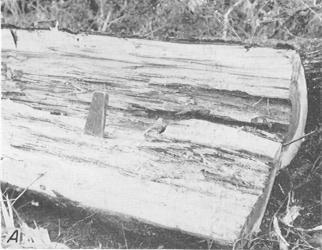
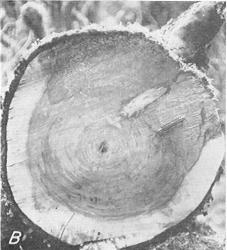

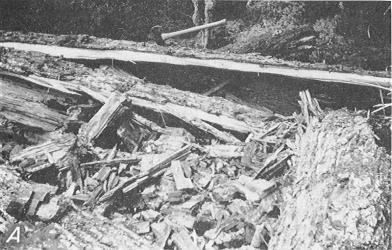


The rust-red stringy rot of the Indian paint fungus is virtually nonexistent in the central coastal regions. However, this is by far the most prevalent rot in western hemlock stands of the interior.
In these interior stands, the order of cull production for the above fungi is 9-3-7-2-5-1-4-8-6. In Alaska, the order of importance is 5-1-8-4-3-6. Numbers 7 and 2 are found in western hemlock, but not in living trees, and nurnber 9, the Indian pamt fungus, has not been found ill western hemlock in Alaska.
The four brown rots that produce significant amounts of cull and their causal fungi, listed in order of their general importance in coastal stands of western hemlock, are as follows:
| Name | Causal fungus |
| 1. Brown crumbly rot. | Red belt fungus (Fomes pinicola (Sw.) Cke.) |
| 2. Brown cubical rot. | Sulfur fungus (Polyporus sulphureus (Bull.) Fr.) |
| 3. Brown cubical pocket rot. | Brown Stereum fungus (Stereum abietinum Pers.) |
| 4. Red-brown butt rot. | Velvet top fungus (Polyporus schweinitzii Fr.) |
But in the interior stands, the order of cull production for the brown rots listed above is modified slightly to 1-3-2-4. Number 3, the brown cubical pocket rot, has not been reported from Alaska.
However, the other three occur there in the same order as in other coastal stands.
Location in the Tree
About one-third of the heart rots of western hemlock are usually classed as root and butt rots, and two-thirds as trunk or top rots. Some of the so-called root and butt rots, such as those of the Fomes root fungus, the velvet top fungus, and the sulfur fungus, may extend 40 or more feet up the bole in western hemlock and thus cause greater loss in this troo species than in others. For not only is more cull associated with these fungi in western hemlock than in other species, but the largest and highest grade logs are affected. The growth pattern of these fungi in western hemlock is probably influenced by the moist, cool sites the trees grow in and the relatively high water content of the heartwood of its basal logs. However, in western hemlock, as in other forest trees, the rots of the shoestring fungus, the shelf fungus, and the white root fungus are confined to the roots and butt.
The ring scale fungus and the Indian paint fungus usually enter the bole through branch stubs that contain heartwood and are therefore considered trunk rots; they affect that part of the bole that produces branehes large enough to contain appreciable amounts of heartwood. In dense stands of the coastal areas, early natural pruning usually prevents growth of branches of this type on the lower parts of the bole, and consequently these fungi rarely infect the lower logs. However, in the inland stands, whieh are more opengrown, these rots may extend down the trunk to the ground.
The other trunk or top rots are associated with trunk wounds, and, therefore, their location depends upon wound location. Some, however, particularly the rot caused by the yellow cap fungus, may extend as much as 60 feet beyond the wounded area.
Entry Points for Fungi
Decay fungi usually enter the heartwood through breaks or other wounds in the bole or roots, or through branch stubs; some fungi, such as the Fomes root fungus and the shoestring fungus, which grow in decayed wood in the soil, may enter by penetration of sound roots. The ring scale fungus and the Indian paint fungus usually enter through normal branch stubs that contain heartwood. The small branches of the lower bole that are normally suppressed in dense pole stands do not usually contain enough heartwood for the establishment of these fungi.
Other heart rot fungi will enter wherever heartwood is exposed in a wound. The nonresinous nature of hemlock wood makes wounds exceptionally vulnerable to entrance of fungi, because wounds do not produce a covering of pitch as they do in species such as pines. Even when only sapwood is exposed in a wound, heart rot fungi may eventually enter. Some fungi, such as the bleeding Stereum fungus, the camouflage fungus, and the red belt fungus, enter the heartwood after decaying the sapwood; others attack the heartwood after sap-rot fungi have decayed the sapwood.
Basal fire scars and frost cracks are common entrance places for both butt-rot and trunk-rot fungi. Open dwarfmistletoe cankers on the bole or on branches enlarged by this parasite afford entrance for fungi, such as the camouflage fungus, the yellow cap fungus, the shelf fungus, and the red belt fungus. The camouflage fungus decays not only heartwood and dead sapwood but also the living sapwood (fig. 1, B) , thereby killing the cambium over large areas of the bole; sometimes this fungus kills the entire tree.
The white root fungus, the bleeding Stereum fungus, the shelf fungus, the yellow cap fungus, the sulfur fungus, and the velvet top fungus usually enter wounds near the tree base or on the roots where moisture is high. The other wound-entering fungi, particularly the Fomes root fungus, will enter a wound anywhere in the tree.
Indicators
Conks and old wounds are the principal indicators of heart rot in living trees. Conks on the bole are the usual indicators of heart rot of the Indian paint fungus (fig. 3, A ) and the ring scale fungus; the number, size, and vertical spacing of these frUltmg bodIes proVIde a means of estimating the extent of decay. Other fungi such as the camouflage, shelf, bleeding Stereum, red belt, sulfur, and brown Stereum also commonly produce fruiting bodies on the tree, but usually these are associated with wounds, which are themselves indicators. Conks of the velvet top and shoestring fungi may grow on the butt of the tree, but are commonly found on exposed roots or on the ground at the base of the tree. Conks of the Fomes root fungus, yellow cap fungus, and the white root fungus are rare, but may sometjmes be found in basal fire scars or similar open wounds near the ground.
Heart rot is associated with nearly all old wounds in western hemlock. The most common scars are those caused by other trees falling against the bole (fig. 3, B), but frost cracks, dwar£mistletoe cankers, broken tops, dead or "spike" tops, lightning wounds, fire scars, and old logging wounds are good indicators of decay.
The common "black knots" (fig. 3, C) of western hemlock often are mistakenly thought of as indicators of heart rot, but these black exudates are in no way associated wjth wood decay.
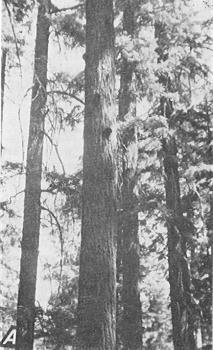
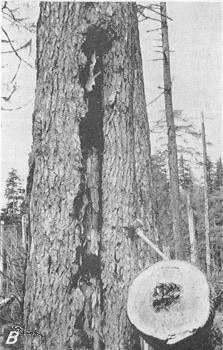
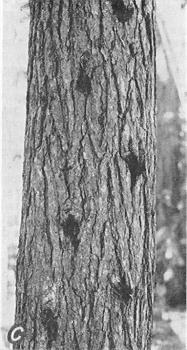
Figure 3. - Conks and an old wound that indicate heart rot in the bole of western hemlock trees, and black knots, which do not indicate heart rot: A, Conks of the Indian paint fungus. The number, size, and spacing provide a means of estimating the extent of decay in the tree. B, Old falling tree scar in tree butt, and a cross section of the bole showing extension of heart rot 40 feet above the scar. C, Black knots, a common phenomenon not associated with heart rot of hemlock, but often mistakenly thought of as an indicator of heart rot.
Minimizing Future Losses
As virgin hemlock forests are converted to managed young-growth stands, the total volume of cull from heart rot can be expected to decrease. The rotation age of these managed young-growth stands will be less than the age at which heart rots usually cause appreciable damage to unmanaged western hemlock stands. But heart rots must be prevented from gaining early entrance into these young trees if serious decay losses are to be avoided.
Future losses from heart rot may be minimized by reducing mechanical injuries during logging and by weventing fires, particularly ground fires that produce wounds at the base of tree trunks. In managed forests, infection by the ring scale fungus and the Indian paint fungus may be reduced by maintaining fully stocked stands, there-by encouraging natural pruning before branches contain appreciable heartwood.
Intermediate cuts should remove all decadent trees, as well as those with broken tops, sizable wounds, or conks. In felling and logging, special care should be taken to prevent breaking the tops of, or otherwise wounding, trees in the residual stand. Root and trunk wounds can be reduced by confining logging tractors to properly located skid trails. If seed trees bearing conks are retained in old-growth stands, they should be left only long enough to insure regeneration. Fruiting fungi on western hemlock do not always produce conspicuous conks, but they do produce spores and thus threaten other trees in the stand; therefore, early cutting of all decadent, overmature trees is recommended as a sanitation measure.
References
Decay in western hemlock and fir in the Franklin River area, British Columbia. D. C. BUCKLAND, R. E. FOSTER, and V. J. NORDIN. Canad. Jour. Res., C. 27: 312-331. 1949.
Decay of western hemlock in western Oregon and Washington. G. H. ENGLERTH. Yale Univ. School Forestry Bul. 50, 53 pp. 1942.
Decay of western hemlock and amabilis fir in the Kitimat Region of British Columbia. R. E. FOSTER, J. E. BROWNE, and A. T . FOSTER. Canada Dept. Agr. Pub. 1029,37 pp. 1958.
Decay of western hemlock in the Upper Columbia Region, British Columbia. R. E. FOSTER, H. M. CRAIG, and G. W. WALLIS. Canad. Jour. Bot. 32: 145-171. 1954.
Decay of western hemlock on the Queen Charlotte Islands, British Columbia. R. E. FOSTER and A. T. FOSTER. Canad. Jour. Bot. 29: 479-521. 1951.,/
Decay associated with thinning wounds in young-growth western hemlock and Douglas-fir . J. HUNT and K. W. KRUEGER. J our. Forestry 60: 336-340. 1962.
Cull factors for Sitka spruce, western hemlock, and western red-cedar in southeast Alaska. JAMES W. KIMMEY. U.S. Forest Serv. Alaska Forest Res. Center Sta. Paper 6, 31 pp. 1956.
The occurrence of the Indian paint fungus, Eehinodontium tirwtorium E. & E. in British Columbia. G. P. THOMAS. Canada Dept. Agr. Pub. 1041, 30 pp. 1958.
A study of heart-rot in western hemlock. JAMES R. WEIR and ERNEST E. HUBERT. U.S. Dept. Agr. Bul. 722, 37 pp. 1918.
Decay following logging injury to western hemlock, Sitka spruce, and true firs. ERNEST WRIGHT and LEo A. ISAAC. U.S. Dept. Agr. Tech. Bul. 1148, 34 pp. 1956.
U.S. DEPARTMENT OF AGRICULTURE
WASHINGTON, D.C. 20250
OFFICAL BUSINESS

